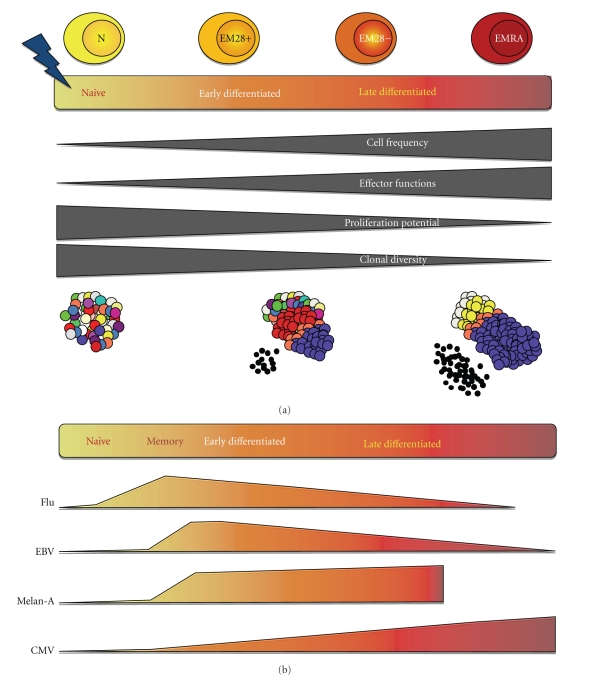Figure 2.
Model of CD8 T-cell differentiation. (a) The highly diverse naive T-cell compartment contains T-cell clonotypes of very low frequency (represented by one color), and null expression of effector mediators but high potential for proliferation in response to antigen. Following encounter with cognate antigen, CD8 T-cells are activated and begin a process of cellular differentiation characterized by a gradient of early- and late-differentiated cellular states, that can be described by changes within four major parameters as depicted by dark grey blocks. As a result of the massive cellular proliferation that ensues activation, there is an increase in the frequency of T-cells and a restriction in the TCR diversity, since the pool of primed differentiated T-cells is composed of a small number of clonally expanded T-cells (blue, white, yellow, and orange T-cells). Concomitantly, there is a decrease in proliferative potential from naive and early differentiated T-cell subsets towards highly differentiated subsets. Moreover the accumulation of effector functions (high production of effector molecules, small black dots) in these expanded populations of T-cells defines further maturation of differentiated T-cells. (b) The degree of differentiation of T-cells along this spectrum has been shown to vary with antigen specificity. As such, the antigen-specific responses against influenza virus and against persistent EBV and CMV viruses are compared with the tumor-specific response against the Melan-A antigen, while taking into account the four parameters described in (a). EBV-specific cells are more differentiated than influenza-specific cells but less so than CMV-specific cells which are composed primarily of highly differentiated CD8 T-cells. While both early and late differentiated subsets have also been identified in Melan-A specific responses, their proportions are highly variable between different patients following vaccination. In addition, tumor-specific responses contain a much lower fraction of highly differentiated EMRA (effector memory CD45RA+) cells compared with viral-specific responses.

